Japan
Wood Products Prices
Dollar Exchange Rates of 10th
Jul
2022
Japan Yen 137.43
Reports From Japan
Ruling coalition maintains its
hold on power
As expected the ruling coalition in Japan won the majority
of seats in the recent upper house election. This was a
success for Prime Minister Kishida but the victory was
overshadowed by the shooting at a rally of former Prime
Minister, Shinzo Abe.
Machinery orders fall
The total value of machinery orders received by 280
manufacturers operating in Japan increased by 2.5% in
March from the previous month on a seasonally adjusted
basis.
In the January-March period it declined by 9.7% compared
with the previous quarter.
Private-sector machinery orders, excluding volatile ones
for ships and those from electric power companies,
increased a seasonally adjusted by 7.1% in March but
declined by 3.6% in the first quarter.
In the April-June quarter the value of machinery orders
was forecast to increase by 5.2% but private-sector orders,
excluding volatile ones, were forecast to drop.
The Cabinet Office that compiles the machinery order
report said companies still show an appetite for investment
but added it is necessary to pay attention to downside risks
such as high raw material costs amid Russia's war in
Ukraine.
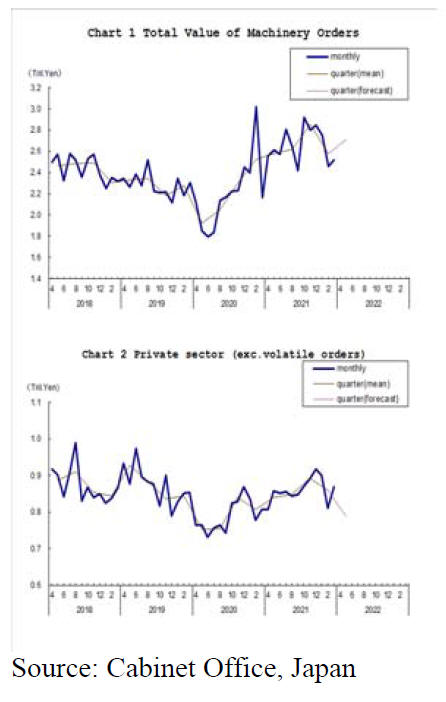
Core machinery orders measures the change in the
total
value of new orders placed with machine manufacturers,
excluding ships and utilities. It is a key indicator of
investment and a leading indicator of manufacturing
production.
See:
https://www.esri.cao.go.jp/en/stat/juchu/2022/2203juchue.html
and
https://mainichi.jp/english/articles/20220711/p2g/00m/0bu/026000c
Yen at lowest since 1998
The yen fell to as low as 137.27 against the US dollar, its
lowest level since September 1998, after the Governor of
the BoJ stated that the Bank will not hesitate to take
additional easing measures if necessary. The yen¡¯s decline
was also because of the improved US job data for June and
this fueled speculation that the US Federal Reserve may
raise interest rates further.
See:
https://mainichi.jp/english/articles/20220711/p2g/00m/0bu/047000c
Japanese commentators are suggesting the Bank of Japan
(BoJ) is getting to the point where it may have to change
policy direction as central bankers around the world
tighten monetary policy to rein in high inflation.The BoJ
has sought to remain loose monetary policy but the
economy has been stuck in a low growth, deflationary
environment for many years which has prompted the BoJ
to maintain pump money into the economy.
See:
https://www.cnbc.com/2022/07/07/japan-could-be-about-tosurprise-markets-with-monetary-policy.html
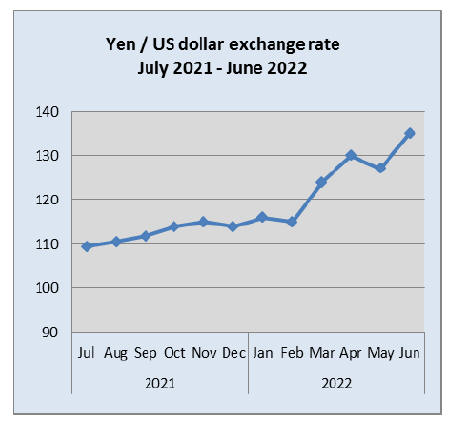
Double digit price increases
Households in Japan are reeling from surging prices as the
rise in BtoB wholesale prices, which rose 9% in June, are
being passed to consumers.
Prices for petroleum and coal products jumped 22%, while
those for iron and steel gained 27%. Wood and sawnwood
prices surged over 40% in June, a relief from the almost
60% rise in May. Electricity, gas and water prices which
move in tandem with energy prices rose 28% in June.
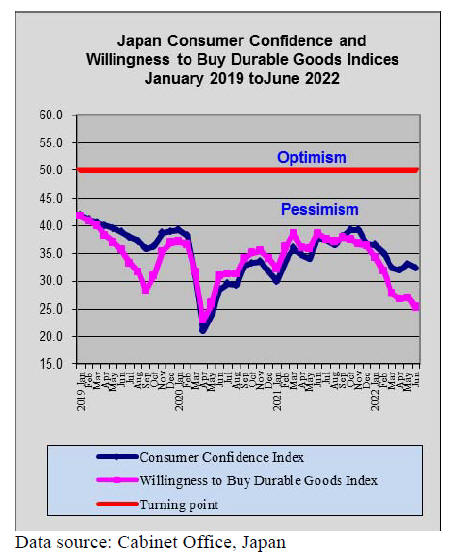
Weak yen attracts foreighn buyers to housing
market
The weak yen has attracted Hong Kong investors to the
Japanese real estate market, especially for on Tokyo¡¯s
waterfront and studio apartments in smaller cities where
rental income can be good.
International property agents sales as the yen fell and
expectations for an end to anti-Covid border controls have
spurred interest.
Prices of new condominiums in Tokyo rose above the
record set in 1990 but even with the gains apartments in
Tokyo remain cheaper per square metre than those in
London, New York and especially Hong Kong.

April office furniture imports (HS 940330)
There was a sharp drop in the value of wooden office
furniture (HS940330) imports in April. Compared to a
month earlier imports were down 22% and year on year
April 2022 imports dropped 38%.
The biggest decline was in imports from China which
were down around 35% and imports from Italy dropped
steeply.
On the other hand imports from Poland were up by a
factor of three. Shippers in Thailand and Malaysia also did
better in April compared to a month earlier.
As in previous months the top shipper of wooden office
furniture in April 2022 was China accounting for 70% of
total wooden furniture imports (85% in March). The only
other shipper of note in April was Poland which accounted
for about 13% of total imports.
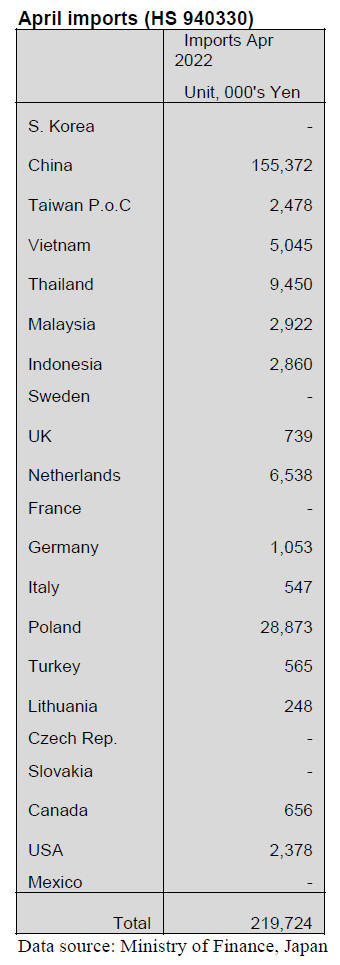
April kitchen furniture imports (HS 940340)
Shippers of wooden kitchen furniture (HS940340) in
Vietnam did well in April. Shipments from Vietnam were
up over 30% compared to a month earlier. Shipments from
Thailand dropped by half in April.
Year on year April 2022 shipments were up around 10%
but compared to March there was little growth. There were
two major shippers of wooden kitchen furniture in April,
the Philippines and Vietnam and manufacturers in these
two countries have a commanding position in imports of
wooden kitchen furniture each accounting for around 40%
of all wooden kitchen furniture imports.
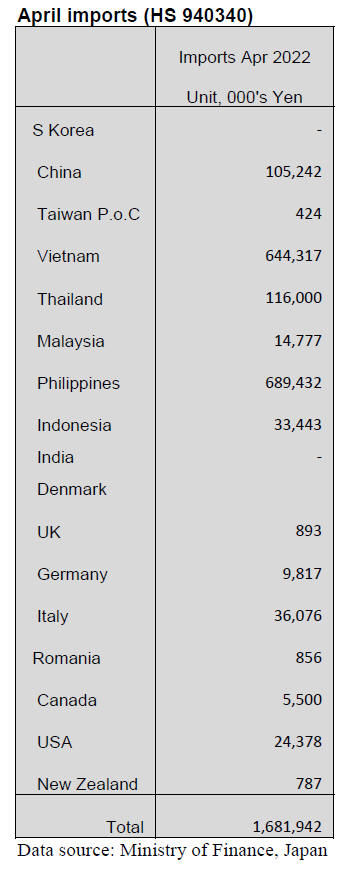
March bedroom furniture imports (HS 940350)
Except for the slight dip in the value of imports in
February this year Japan¡¯s imports of wooden bedroom
furniture (HS940350) continue to rise. Compared to
March imports there was a 15% rise in April and year on
year April 2022 imports were up 22%.
The driver of the continued rise in the value of wooden
bedroom furniture is difficult to identify. Consumer
sentiment and willingness to buy durable goods was
dropped in the first quarter and showed no sign of
recovery in the second quarter and in April the yen
exchange rate had begun to weaken pushing up the price
of imports but despite this imports of bedroom furniture
steadily rose.
One possible explanation is that domsectic manufacturing
has fallen creating the need for increased imports to
sustain demand.

Trade news from the Japan Lumber Reports (JLR)
The Japan Lumber Reports (JLR), a subscription trade
journal published every two weeks in English, is
generously allowing the ITTO Tropical Timber Market
Report to reproduce news on the Japanese market
precisely as it appears in the JLR.
For the JLR report please see:
https://jfpj.jp/japan_lumber_reports/
Demand and supply of logs in 2021
The Ministry of Agriculture, Forestry and Fisheries
announced a result of demand and supply volume of logs
in 2021.Logs for lumber, plywood and chips were
26,085,000 cbms, 10.8% more than 2020¡¯s.
Domestic logs were 21,847,000 cbms, 9.9% more than
2020 and imported logs were 4,238,000 cbms, 15.5%
more than the previous year. The domestic logs were
83.8% of the total volume and it was0.6 point decreasing
from 2020 but it has been keeping a level of 80% for five
years.
The volume was around 26,000,000 cbms in 2016 ¨C 2019
and it was under 24,000,000 cbms in 2020. It was decline
for the first time in ten years. The volume of imported
lumber decreased at the beginning of 2021 and then the
demand was shift to the domestic lumber so the volume of
domestic logs increased to 26,000,000 cbms. The domestic
logs for lumber were 12,860,000 cbms, 10.7% more than
last year and for plywood was 4,660,000 cbms, 11.1%
more than last year.
The volume of softwood logs exceeded the volume of
2019 but the volume of hardwood logs did not.
Cedar logs for every category increased and it was
12,920,000 cbms, 10.8% increased from 2020.
Cypress logs for lumber and plywood increased but for
chips, it did not. The total volume was 3,080,000 cbms,
13.1% increased from 2020. Fir and whitewood volume
was 1,200,000 cbms, 28.3% more than 2020 due to
increase for plywood use. Larch volume was 1,990,000
cbms, 1% less than 2020 even though larch lumber
volume increased.
The volume of red pine and black pine was 530,000 cbms,
7.2% less than 2020 because the volume of lumber and
chips decreased. For imported logs, the volume of North
American logs was 3,450,000 cbms, 21.3% more than
2020. The volume of lumber and plywood increased a lot.
The volume of lumber exceeded 3,000,000 cbms for the
first time in three years.
Economic sanctions on Russia
The Ministry of Economy, Trade and Industry added
economic sanctions on the list of banned export to Russia.
Veneers, wooden containers, lumber, corks, machines and
machine parts were not allowed to export to Russia as of
17 June.
These economic sanctions followed the U.S.A. and
Europe¡¯s sanctions. New additions are veneers for
decorative boards and plywood, wooden barrels, buckets
which will be banned exporting. Lumber and corks for
machines will be also banned. Japan used to export
veneers for decorative plywood to Taiwan, South Korea
and Indonesia before but not to Russia.
There are no Russian lumber companies would not be able
to produce for Japan if they could not get machine parts
when they do maintenance.
Improved plywood for crating
Honda Lumber Co., Ltd. and Meiwa Corporation started
selling improved plywood for crating at Kitakyusyu City
in June. It took about a year to improve the plywood. The
plywood is water-repellent and fungicide. The companies
changed a glue company to reduce the cost and the glue is
better and stronger than before.
Mold and inundation have been a problem at distribution
business due to COVID-19. They are exposed to weather
in long time. The companies would expand selling the new
plywood not only in Japan but also in overseas. Size is
1,230x2,440 mm and yearly volume would be 600 cbms.
Domestic logs and lumber
Demand of domestic lumber is stalling since early June
and sales are slowing. 105 mm square is still moving but
120 mm square has no demand.
Meantime, log production is active and sawmills continue
full production despite dull movement of lumber.
Since balance of supply and demand is collapsing, prices
of structural items are getting weaker all over Japan.
3 meter KD cedar 105 mm square prices are 100,000-
110,000 yen per cbm FOB yard so far but in Tokyo
market, there are 90,000 yen level of prices are seen so
further slide is likely. 3 meter KD cedar 30x105 mm stud
prices are holding at 90,000-100,000 yen.
Standard cedar lumber prices are much steadier than
structural lumber. Substituting demand of Russian lumber
after the Ukraine war broke out is now totally simmered
down since Russian lumber continues coming in.
Log production continues steady even after rainy season
started in June and log inventory of sawmills is plenty
now. Plywood mills¡¯ log demand is satisfied. Market log
prices are softening with ample inventory. Cypress log
prices are particularly weak.
|